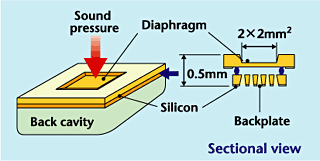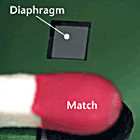|
IC
Microphone
-High-performance, Ultra-small
Silicon Microphone-
 Toshifumi
Tajima, Toshifumi
Tajima,
Advanced Imaging Devices
 |
| Figure
1: Schematic diagram
of IC microphone |
STRL has developed a high-performance,
ultra-small silicon microphone
that is fabricated by a
micro-machining process
based on LSI manufacturing
technology. This condenser-type
microphone consists of a
thin diaphragm, which is
vibrated by sound pressure,
and a back plate (Figure
1). Vibration of this diaphragm
changes the condenser capacitance,
which is then converted
to a voltage that corresponds
to the sound signal.
Conventional microphones
consist of many small parts.
This causes problems in
the final product, including
uneven characteristics and
insufficient durability.
After examining fabrication
technologies, materials,
and structures, we were
able to fabricate (with
an LSI micro-machining technology)
a single-crystal-silicon
condenser-type microphone
(silicon microphone). This
types of microphone has
several advantages:
 |
LSI micro-machining technology produces a microphone with consistently
good characteristics. |
 |
The microphone is formed from single-crystal silicon, which has
a tensile-strength 15 times higher than that of steel. This gives
it a wide dynamic range, in addition to excellent sensitivity and
frequency characteristics. |
 |
It is durable and can be used in high-temperature and high humidity
environments. |
 |
The high degree of freedom in its design means its shape and characteristics
can be optimized for the intended purpose. |
 |
Placing multiple silicon microphones in an array on a silicon
wafer should enhance sensitivity and directionality. |
The fabrication method
uses two silicon wafers
bonded with each other
as a substrate, desired
portions of which are
chemically etched (Figure
2). The range of microphone
design can be enhanced
through the use of STRL's
original processes, such
as those for controlling
the thickness of the bonding
layer and special etching
techniques.
The fabricated silicon
microphone has a 2-mm
square diaphragm and is
0.5-mm thick (Figure 3).
Its sensitivity and frequency
characteristics were measured
and found to be excellent.
This silicon microphone
has a wide range of applications,
from microphones for program
production to general-purpose
appliance microphones,
including those used in
cellular phones.
*Tohoku
University cooperated
in the development of
the process technologies,
such as anisotropic etching
(a technology to etch
a substrate in only the
depth direction).
 |
 |
 |
|
Figure
2: Silicon microphone
fabrication process
|
 |
Figure
3: Diaphragm for
test-manufactured
silicon microphone
|
|

 Toshifumi
Tajima,
Toshifumi
Tajima, 

